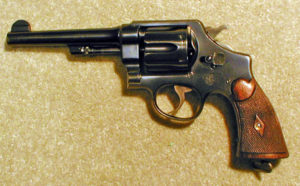 45 Model 1917 Revolver" />
45 Model 1917 Revolver" /> 45 Model 1917 Revolver" />
45 Model 1917 Revolver" />
Revolvers aren’t the first thing that come to mind when I think about military guns. Standing in the shadow of the 1911, M1 Garand or M16 that’s understandable. But it's hard to miss a firearm like the Smith & Wesson Model 1917 Army revolver, with its classic-looking roundish front blade and western-styled grip.
It was a hell-raisin’ handgun for sure, one to be reckoned with, chambered like it was to take care of business. It shot the man-stoppers, the big .45 ACP or .45 Auto Rim. The U.S. was gearing up for World War I.
Reflecting back on the inadequacies of the .38 used with marginal effect in the Philippines, the military adapted relatively quickly and went after a .45 caliber sidearm.
No military gun collection would be complete without the Smith & Wesson Model 1917, which — along with Colt’s New Service .45-ACP — both became known to the Army brass and countless soldiers simply as the M1917.
There is a lot for gun collectors to like about it. If ink spilled in firearms literature is any indication, much found right here at Gun Digest, then this is a significant gun indeed. It has a rich, well-documented history spanning two world wars.

According to the Standard Catalog of Firearms, there were about 163,000 Hand Ejector Models produced for the Army between 1917-1919; 5050 Target Model variations; 1,200 Commercial variations; and an additional 25,000 under Brazilian contract.
One might also locate the more commercialized version, the 1917 Postwar Model, of which 10,000 were produced in the 1930s, and were still being sold into the ‘50s. Prices of this 5 ½-inch barreled N-frame double action start at around $175 for poor grade and go on up into the neighborhood of $700 for a New-in-Box (NIB) Hand Ejector, or $1200 or more for a really nice .455 Mark II Hand Ejector First Model.
This was a sidearm born of necessity. The U.S. needed to fill a shortage of handguns as involvement in the First World War loomed. Thus it made perfect sense for Smith & Wesson to tool up for a .45 ACP revolver — one that could use ammo already being produced for the new 1911s interchangeably.
“Smith & Wesson’s Model 1917 revolver can perhaps best be described as an expedient that actually worked,” wrote Tom Osborne in Smith & Wessons of the Great War, from Gun Digest 2011. “Procuring revolvers to supplement the semiauto pistols seemed a reasonable solution to the handgun deficit.”
Smith & Wesson engineers developed “half-moon” clips to eject the .45 ACP rimless cartridges. Colt later took advantage of the innovation for the same purpose.
And while the M1917 does indeed have a fascinating history for people tuned into such things, I don’t believe people buy guns because they have an intriguing story. Sometimes we just like the way a gun looks, and I dare say this is one sixgun that has very nice lines. Like most all Smiths, it's reported to be a dandy shooter, too.
Whether you call it a collecting strategy or a rationalization, we gun lovers, like coin collectors, are masters at inventing excuses to search out and buy a new ‘arm. For instance, the M1917 could be the basis of a very neat revolver collection. A Smith & Wesson collection. Or just a collection of various M1917s, and other caliber hand ejectors of that era. For me, I envision this as an ideal gun to compliment a Springfield Model 1903 rifle making a great World War I era gun collection.
No matter how or why this little revolver trips your trigger, we’ve got lots of resources to learn more about it. Dave Workman reflects upon the gun’s contemporary use for hunting and Wild Bunch competition in The Model 1917: A Great Old Revolver. And further research can be done on this classic piece by picking up a copy of Classic Combat Handguns, in which Lee Arten talks about shooting his M1917 in Too Many 45s? Of course, be sure you have an up-to-date copy of the Standard Catalog of Firearms. There is a lengthy section on the M1917, with historical reference and values.
“Over nine decades have passed since peace was declared on that first Armistice Day, November 11 th 1918,” concludes Osborne. “Virtually all those who fought in the ‘War to End All Wars’ are now gone. But these … revolvers and others like them remain as an unforgotten link to that time and those men.”

Enhance your shooting precision with our 62 MOA Targets, perfect for rifles and handguns. Crafted in collaboration with Storm Tactical for accuracy and versatility.
Subscribe to the Gun Digest email newsletter and get your downloadable target pack sent straight to your inbox. Stay updated with the latest firearms info in the industry.